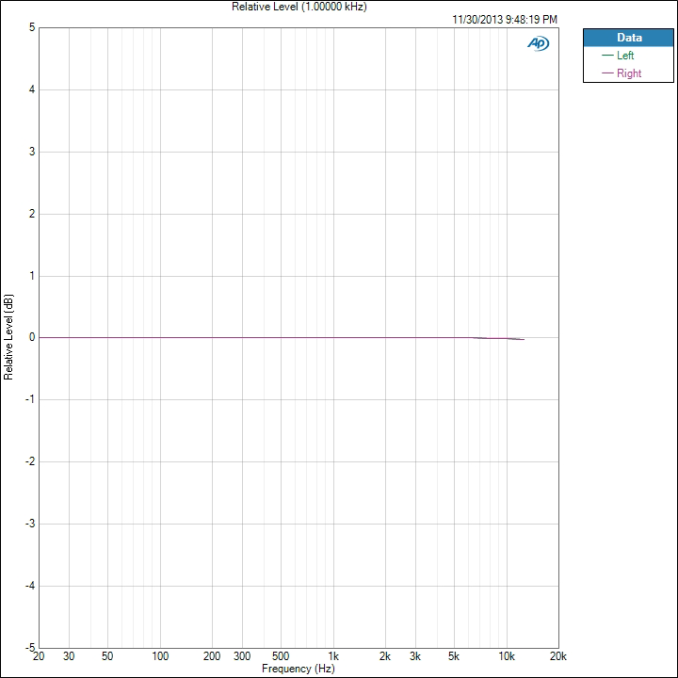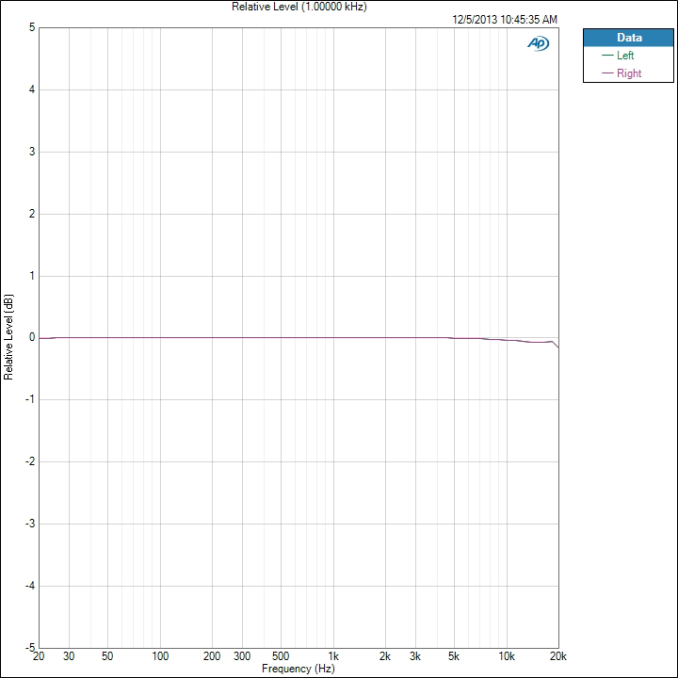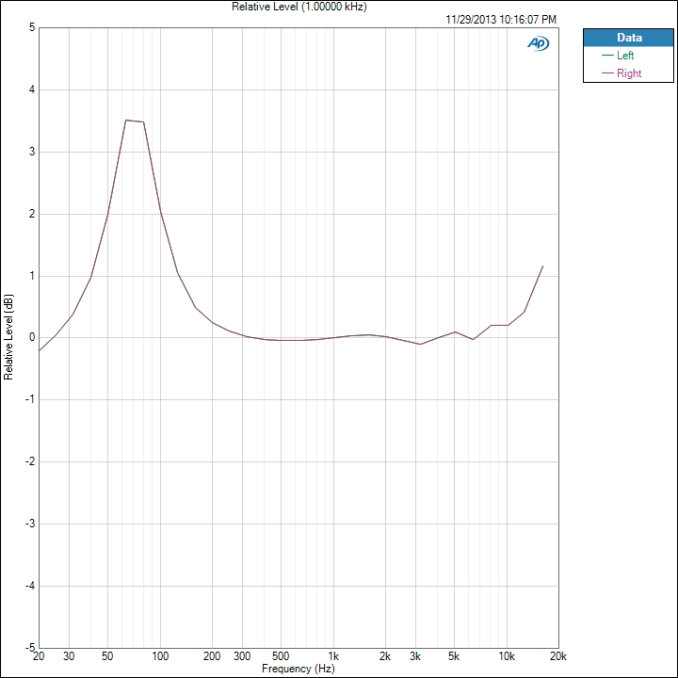Smartphone Audio Quality Testing
by Chris Heinonen on December 8, 2013 5:15 PM EST- Posted in
- Smartphones
- Audio
- Mobile
- Tablets
- Testing
Maximum Level
The maximum output level is derived from the 1kHz test tone used to determine THD+N. The higher the output from the headphone jack, the louder it can drive a pair of headphones. More importantly, having more power available means when you have dynamic music passages that call for power you are less likely to clip the waveform.
There is no chart to show here, just a number that the Audio Precision gives us. In our test data, the most powerful phone was the iPhone 5, at 32.46 mW of power. Next is the Nexus 5 at 22.24 mW, though we can’t drive it that high. Then the Note 3 at 11.81 mW and finally the Galaxy S4 at 3.895 mW. Doubling the power, from 4 mW to 8 mW, produces a 3 dB increase in volume level. 3 dB is the smallest change in volume levels we can easily hear. So even though the iPhone 5 produces 32 mW vs. 4 mW, that is only a 9 dB difference in volume. 10 dB is doubling the volume, so it isn’t even twice as loud. If you have demanding headphones, you will want as much power as you can get.
Frequency Response
To measure the frequency response we measure a set of 61 tones from 20 Hz to 20 kHz. All of these are then equalized to 1 kHz so we can see the maximum deviation from that level. An ideal phone will be perfectly flat here and allow you to adjust this with an EQ setting, or though your taste in headphones. On this test our best performing phone is the Galaxy S4, as seen here.
The total variation from 1 kHz is only 0.014 dB which is very good. The worst performing phone is the iPhone 5, but its variation is only 0.089 dB.
The iPhone 5 also picked up the 20 kHz tone while the Samsung and many others missed it. If we dropped this tone then it might be just as flat. The iPhone 5 test was run slightly differently, as it can't run the Android test program, which might account for this. For a phone with a different response, here is the HTC One with Beats enabled. Other HTC One testing is still in progress as I write this article.
Here we see that Beats is adding a +3.5 dB boost from 60 Hz to 90 Hz, but the deviation from 0 dB goes from 30Hz to 300 Hz. Past 6.5 kHz we also see a rise in the treble. People often mistake boosted treble for extra detail, which is likely the reasoning behind this. As we see it is far different than the other two examples we looked at.













188 Comments
View All Comments
Origin64 - Monday, December 9, 2013 - link
"Here we see that Beats is adding a +3.5 dB boost from 60 Hz to 90 Hz, but the deviation from 0 dB goes from 30Hz to 300 Hz. Past 6.5 kHz we also see a rise in the treble."And people pay 300 bucks for a headphone that does exactly, and only, this. Its a good joke, really.
willis936 - Monday, December 9, 2013 - link
To Chris:Check out NwAvGuy's blog if you haven't already. He appeared and disappeared a few years ago bringing with him a headphone amp design and (more importantly) a breath of fresh, objective air in testing audiophile headphone equipment. He has some good data there and comparing testing methodologies might be insightful for things to try here on anandtech.
cheinonen - Monday, December 9, 2013 - link
I've read his full blog and wish it was still updated.Impulses - Monday, December 9, 2013 - link
Tyll's Inner Fidelity blog is another great resource.adityanag - Monday, December 9, 2013 - link
This is excellent. Also the reason why I've been reading Anandtech since 1998. Keep up the great work, guys.Gadgety - Monday, December 9, 2013 - link
I appreciate this article, Chris. An improvement would be a summary table of all the models compared on one page, and some sort of analysis beyond the "poor performance" comparison. I've also seen data that the specs will change significantly for worse when headphones are attached to the phones.xodusgenesis - Monday, December 9, 2013 - link
Finally some in-depth audio anlysis. I've been waiting for this as I actually use my smartphone as a phone (I know shocker in today's age) and media player most of the time.ZoSo - Monday, December 9, 2013 - link
Would like to see some results of a few current WP8 phones, Nokia in particular.asgallant - Monday, December 9, 2013 - link
Awesome! I have been wanting to see some audio analysis done for a while now. Is there any chance of extending this to test audio on motherboards, sound cards, and laptops as well?lever_age - Monday, December 9, 2013 - link
Glad to see this. My suggestions are as follows:1. Include an output impedance measurement. If you're using these as decent-quality audio players with headphones, this is one of the most important things to know for certain headphones, at least. Who cares what the measured frequency response with a resistor is if your source's output impedance is causing +/- 5 dB swings in response for some balanced armature IEMs?
2. Standardize THD+N tests to a given output level for all phones (say 0.1 V or whatever else; the danger is picking something standard like 0 dBu that some phones could possibly not even reach). Don't just use whatever the max volume is, especially since that's into clipping territory for some phones. People don't scale their playback levels by how much power the electronics is capable of handling. I hope. Referencing a fixed level is more fair.
3. Please do keep reporting which phones run into clipping (and at what load) at volume settings at max or less. Also what some nonstandard settings like Beats Mode do.
4. Make careful distinction of THD with headphones as load and as not. If not loading with headphones-level impedance that is mostly testing the performance when hooked up to say a speaker system with a patch cable, which I don't think many people are doing these days.
5. When reporting maximum level, standardize to point of say 1% THD (or max volume, whichever comes first). Also note if headphones are used or not. It'd be meaningless to quote maximum levels far past the point of clipping.
6. If you have time, see if you can coax and measure some bad behavior out of the phone by using Wi-Fi, Bluetooth, LTE, etc. simultaneously, maybe some CPU/GPU load and seeing if that causes audio issues. Honestly, glitchy or cackling playback are far greater issues to audio quality than looking at 0.3 vs. 1 dB dips in frequency response at 19 kHz or something like that. Or output power levels most people don't need.